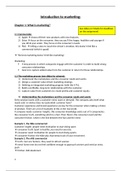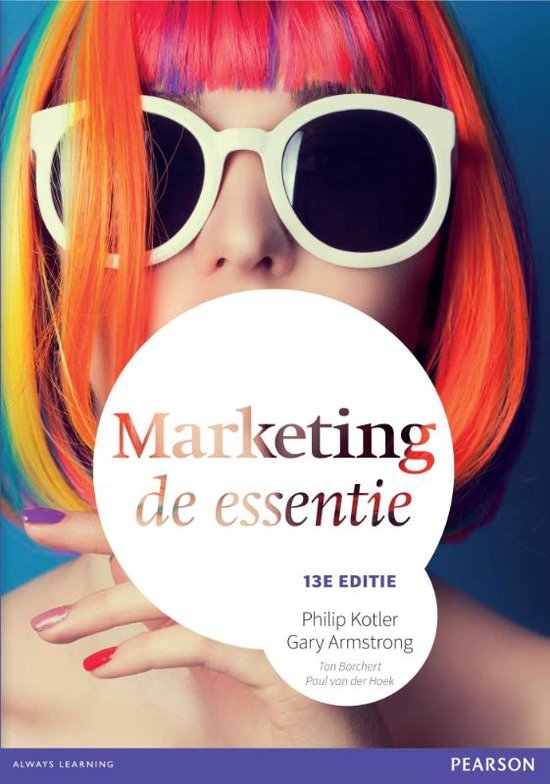Introduction to marketing:
Chapter 1: What is marketing?
See slides on Toledo for deadlines
on the assignment!
1.1 Commercials:
1) Apple shows off their new products with new features.
2) Evian focus on the consumer, they say you’ll live happy, healthier and younger if
you drink your water. They focus on the consumer’s needs.
3) P&G telling a story to touch the viewer’s emotion, this doesn’t feel like a
commercial (which is good)
The best marketing doesn’t feel like marketing!
Marketing:
5-step process in which companies engage with the customer in order to build strong
consumer relationships.
Goal is to capture added value from the customer in return for these relationships.
1.2 The marketing process (see slides for scheme):
1) Understand the marketplace and the consumer needs and wants.
2) Design a customer-value driven marketing strategy.
3) Defining an integrated marketing program (with the 4 P’s).
4) Build a profitable, long-term relationships with the customer.
5) Capture value from customers to create profits and customer equity.
1) Understanding the marketplace and the consumer needs and wants:
Every product starts with a customer need, want or demand. The company asks itself what
needs and/ or wishes does my (potential) customer have?
Customer experience and brand experience are key for the consumer when making a choice
of product. There are a lot of examples of this in the real world.
A company needs customer insights, this consumer knowledge exists out of 3 components:
the consumer truth, something which is a fact. Then there’s the consumer need and the
consumer friction, which is the link between the fact and the need.
Example 1, the Nike commercial:
Customer insight: people need motivation to start doing sport.
consumer truth: Sport is healthy, you need to exercise.
consumer need: motivation for people to start doing sports.
consumer friction: the Nike plus that keeps track of your movement.
Example 2, The AXE commercial:
truth: men are hunters, they want to attract women
need: Some men do not feel confident enough to approach women and need an extra
push
friction: AXE deodorant.
1
,360-marketing campaign: campaign that brings the same message over different channels.
E.g. internet, television, radio…
Customer satisfaction: The customer has a certain value perception of a brand. (image,
thoughts about a brand). When the value perception is met (=perceived value), the
customer is satisfied with the product. It’s even better when the perceived value is better
than the value perception.
2) Designing a customer value-driven marketing strategy:
- You think about the need or want of the customer which you want to meet.
- STP process (Segmentation, Targeting and Positioning which customers do we
want to serve?)
- With which value proposition do we want to target the customer.
Example of Jupiler:
- The need they want to meet is thirst
- Targeting: people who think they are adventurous, who want to have a good time
with friends.
- Positioning: they offer a beer, they don’t really compare themselves with the
competition, they just say that they’re the best-selling brand.
Marketing management process:
- Concepts of marketing management:
production concept:
inside-out concept, the company pushes its product to the consumer.
2 situations: When there’s mass production or when the demand is higher than the
supply.
E.g. Ford model T
product concept:
Inside-out: focus lays internally
Marketing myopia: Company doesn’t ask itself if the consumer wants the product.
E.g. Elon Musk with SpaceX, google glass and the Samsung example.
Selling concept:
All about selling products
Inside out
In 2 situations: For unsought goods (e.g. life insurance, blood donations …), The sales
(solden)
ST-result: Short-term, they want fast results.
Marketing concept:
Outside-in: focus lays on the consumer
E.g. Hello Fresh, Disney…
2
, Societal marketing concept:
Outside-in
Pure marketing
E.g. fast-food chains
3 considerations: People, Planet, Profit
E.g. the Lush example from slides, example from Waitrose.
3) Defining an integrated marketing program (4 P’S)
- Product
- Place
- Promotion
- Price
4) Build a profitable, long-term relationships with the customer.
- CRM: Customer relationship management, the companies have information about its
customers, so they can personalize their ads.
- Customer value is very important for brands.
- Brands try to build a relationship through social media, they try to reach the
customer, for example emails, loyalty cards…
- Customer satisfaction is the goal of a lot of the companies.
- You’re only a customer when you buy something from the company, before that
you’re first a suspect (someone that might want to buy but haven’t given a sign that
they are interested everyone), then you become a prospect (when you have
shown interest but haven’t bought yet). After becoming a customer, you become a
relation (you have bought several times), ultimately you become an ambassador (you
recommend the product to people). You can measure this with the NPS (Net
Promoters score) this is calculated by asking in which extend you would recommend
the product to friends/family.
5) Capture value from customers to create profits and customer equity:
Satisfied customer loyal customer (returns and only buys your product), high
customer lifetime value: how much value does a customer bring to a company?
Application, Kinepolis (first four steps):
Step 1:
Customer insight: People want to see the latest movies.
- Consumer truth: New movies are fun to see, but they aren’t available immediately
after being launched.
- Consumer need: A way to see the new movies when they’re not yet available.
- Consumer friction: The Kinepolis movie theatres where people can go and see the
new movies.
Step 2:
USP: They have the best equipment.
- The need which they want to meet is the curiosity about new movies.
- They target a lot of people, everyone who wants to see new movies. They have a lot
of actions to reach young and old.
3





